Coleraine BatteryWorld War Two
A Brief Overview
The Coleraine Battery or 6 Light Anti-Aircraft Battery RA (SR) was made up of over 200 men from Coleraine and Mid-Ulster.
From 1939 – 1945, these volunteers left behind their homes to fight for their country across Europe and beyond.

1939
The Coleraine Battery was established in Coleraine in 1939 and was composed of around 318 personnel from Coleraine and the surrounding areas such as Coleraine, Portrush, Castlerock, Bushmills, Maghera and Kilrea. First mobilised on the 2nd of September 1939, the battery was active until being stood down in 1945.

Nov 1939
In November of 1939, the battery moved to Scotland. There they would carry out a variety of tasks such as an the protection of a four mile square ammunition dump, protection of Anti Aircraft petrol tanks and physical training.

AUG 1940
After a brief break following intense physical training, the Battery relocated to various locations across England. The first location was in Cark, Lancashire where the took part in Bofors Gun training. Following this, they moved shortly after to Minley Camp, Aldershot. Following their time at Minley Camp, the Battery moved to Farnborough, Hampshire and were prepared for travelling to the North East. On September 8th, 1940, the Battery left Farnborough headed to Liverpool where they would board the MV Dominion Monarch en route to Egypt.

NOV 1940
On the night of September 8th 1940, the '6th Light AA (RA) SR Coleraine Battery sailed from Liverpool bound for Egypt. The battery travelled on the Dominion Monarch, as pictured. This voyage would begin on the 9th of April 1940, taking five weeks and stopping at various locations around the African Continent on the way before arriving in Port Tewfiq, Egypt on the 22nd of October 1940.

NOV 1940
After their arrival in Egypt, the Battery moved to Beni Suef, near the capital, Cairo on October 23rd 1940. Here the battery would be equipped and trained for their part in the Anti Aircraft Defence of the Suez Canal.

March 1941
In March 1941, the Battery suffered it’s first death of the war. Alfred ‘Dodger’ Mckeown was travelling in a six-wheel gun tractor undergoing testing following maintenance, when it was hit side on by a truck. Dodger was buried in Ismailia War cemetery beside the Suez Canal.

AUG 1941 - 1943
August 1941 – Western Desert Campaign, North Africa The Battery’s Western Desert campaign was fought across Egypt and Libya. The Battery was split into three groups for this complex and difficult campaign. Their missions included mobile patrols (jock Columns), AA (Anti-Aircraft) and Groundfire Support to Special Forces, AA Support to Field Guns, Railway Defence, Train Defence, Road Defence, Army Headquarter Protection, Airfield Defence and Harbour Defence. Early in the desert war, The battery gained the name of ‘Hope’s Greyhounds’, as under Major hope the battery moved around the desert at high speed. The Battery played a dynamic role in the Western Desert War, this making it difficult to determine the movements of all three units as they worked on separate missions.

1943
Following the Western Desert war in 1943, and they then went on to Amariya’s camp for November 2nd 1943. The Battery then sailed aboard the SS Almanzora sailed out on November 17th, stopping at Fort Agustus, Scotland on November 22nd. During this trip, Y troop were under the command of the ship’s Gunnery Officer. They manned the ship’s 40mm Bofor Guns for the return to the UK. The Battery arrived in Greenock on December 9th 1943. Following a train journey to Lewes, East Sussez, England on December 19th, 1943, leave started. The next time the Battery would be operational would be 10 days after D-Day in June 1944. They would go on to rescue the airborne division, trapped at Arnhem in Holland.

1944 - 1945
At the end of August 1922, the Turkish armieswon their ultimate victory. Within a few weeks, the Turkish mainland was completelyliberated, the armistice signed, and the rule of the Ottoman dynasty abolished

1944
Following their time spent in France the Battery entered Belgium. After travelling to Eindhiven, Netherlands the Battery moved on to Grave, Neerbosch and Nijmegan. The bridge in Nijmegan had already been taken by the 82nd American Airbone. The temporary German hold up had been overcome and the Battery welcomed the new breakthrough. Troops were arriving at Nijmegan after performing serveal acts of bravery that were never mentioned outside each unit. At this stage of the advance, The Battery was positioned for AA duties on the bridge area into Nijmegan. By boxing day of 1944, the Battery had moed 120 miles south into Belgium. In the Ardennes region, South East Belgium the Battery would be standing in three feet of snow.

1945
After the Ardennes, the Battery moved back to Nijmegan then crossed the Nijmegan Bridge and turned west heading for Germany.The Battery moved through the Reichswald forest, Groch and Cleve. The Battery Crossed the Rhine River at Wesel. The Battery had the first gun across the Rhine, finishing up in position ahead of the Infantry. Sgt Norman walkers gun from Y Troop was the first gun over. The final stage of the advance took the Battery to Buxtehude where the Battery carried out garrison duties for the first time.

1945
For the final time, the Battery was posted to Cuxhaven, Germany for Dockyard duties. This is where the war ended for the Battery, in 1945. From here they were moved to Ottendorf, Germany. The demobilisation sped up at this point and the Battery was reassigned as the 96th Battery, Royal Artillery.

JUNE 1996
On Friday, 7th June 1996, the Old Comrades of the 6th light AA Battery (SR) held their 50th and Final Anniversary Dinner in the TA Centre at Artillery road in Coleraine. Due to the advancing years and infirmity of it’s members, the association had decided to make the 50th dinner it’s farewell.


